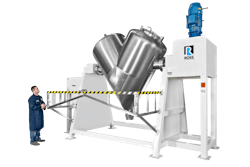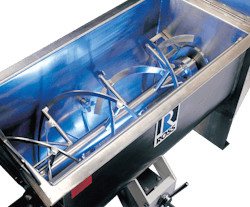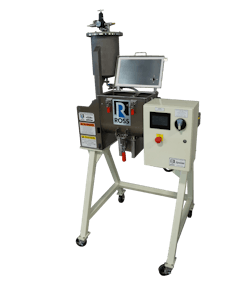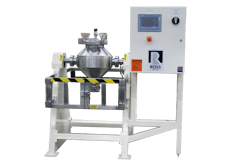Efficiency in bulk solids mixing: Ribbon versus tumble blenders
The current manufacturing landscape is rife with supply chain issues that generally fall out of a manufacturer’s control. To ease the strain on production lines, it is key to have processing equipment that is efficient and able to support growing demand. Choosing the right equipment can be daunting, but due diligence up front can pay great dividends in the long run. For bulk solids mixing processes, several factors must be taken into consideration, such as plant size, budget and batch size, as well as the bulk density and friability of the materials being mixed.
Bulk solid mixers perform a variety of functions, including blending ingredients, heating or cooling, vacuum drying, and coating solid particles with small amounts of liquid. The goal when selecting equipment is to ensure that the equipment will be able to achieve the objectives of the process accurately and efficiently.
Among solid-solid blending systems, two of the most common types are the horizontal ribbon blender and the tumble blender. While both blenders offer superior mixing capabilities and can be customized with advanced recipe control systems, there are some significant differences between them and how each design can best be utilized.
Ribbon blenders
A ribbon blender consists of a U-shaped horizontal trough and an agitator made up of inner and outer helical ribbons that move material in opposite directions. The agitator is powered by a gearmotor drive, which rotates the ribbons at peripheral speeds up to approximately 300 feet per minute and moves material both radially and laterally.
Radially, the outer ribbons move the material inward toward the blender’s center, while the inner ribbons push the material outward toward the blender wall. Simultaneously, the close tolerance between the outer ribbon and the trough wall provides shear.
Versatility is one of the ribbon blender’s major advantages. When mixing a range of products, manufacturers can use interchangeable agitators, such as paddles to handle fragile materials or high-speed chopper blades to quickly break apart large lumps. Ribbon blenders are available in sizes ranging from ½-ft3 lab-scale models through 1,000-ft3 large production systems, making them easily scalable.
Ribbon blenders are widely used for blending dry powders, granules, pellets, flakes, and other solid forms in a variety of industries. Many applications, including food, beverages, cosmetics, chemicals, plastics, agricultural products, animal feed and many others rely on ribbon blenders for quick, dependable mixing, with little chance of overmixing or undermixing, particularly when ingredients have similar particle sizes and bulk densities.
Ribbon blender operation is simple, and the maintenance is minimal. While the ribbon blender is extremely versatile, it is not well suited for some applications, such as sticky materials or very dense powders. Also, highly friable materials are better served by using a low-impact tumble blender.
Other factors to consider when selecting a ribbon blender for maximum efficiency include:
- Cost and scale. From R&D units to full-scale production blenders, ribbon blenders are usually more cost-effective than other types of blending equipment in terms of initial capital cost. The price gap becomes more significant as the blender size increases. For this reason, manufacturers commonly rely on ribbon blenders for large-scale mixing requirements.
- End wall scrapers. Scrapers with a close tolerance (around 1/8 inch) to the end walls of the mixing trough can significantly reduce material packing in the blender’s outermost areas. Radiused trough corners can further eliminate dead spaces in the mixing trough.
- Spray bar and pressure feed vessels. A ribbon blender can be supplied with a spray bar with atomizing nozzles for adding liquid during mixing. A metering pump may be used to feed the liquid at a controlled rate, or the spray bar may be connected to a pressure vessel. Testing is recommended to determine the rate of liquid addition as well as agitator speed, to minimize cycle time without flooding the batch or forming wet clumps of material. Liquids should be sprayed to the center of the batch, or if using multiple nozzles, an equal number on both the left and right sides is desired for optimal results.
- Vacuum drying. Vacuum drying is an efficient method for removing volatile components from granulations, chemicals, plastics, ceramics, metals and other materials. A ribbon blender can be equipped with a heavy-duty cover, clamps, and vacuum-tight seals. The combination of reduced pressure and constant agitation accelerates drying, even at low temperatures. The low-temperature drying process that can be achieved with a vacuum-rated blender is ideal for heat-sensitive materials prone to thermal degradation when exposed to elevated temperatures. The operation also facilitates complete recovery of costly solvents and safe disposal of any harmful materials removed from the batch.
- Air-purged shaft seals. Special seal arrangements, such as air-purged shaft seals, provide increased protection against the risk of product leakage, preventing premature bearing or drive failure and shaft wear. Air purging creates a higher pressure inside the seal cavity, creating an air barrier that prevents material from entering the seal and adding to the life of wear parts.
- Discharge valves. In a typical ribbon blender, material is discharged through an outlet at the center of the trough bottom. The discharge valve assembly must provide a proper seal to prevent material leakage and maintain a safe working environment. Dust-tight knife gate valves are generally suitable for powders and other dry materials. For sensitive applications, consider a sanitary spherical disc valve. With no void between the valve seats, this design features very minimal dead space compared to most other valves and is typically the best design in terms of cleanability, being very easy to assemble and dissemble. Discharge connections can be customized to perfectly mate with the downstream material handling system.
Tumble blenders
With a tumble blender, the mixing vessel is partially loaded with material and then the entire vessel rotates on a horizontal axis. As the blender rotates, the ingredients continually cascade and redistribute within the vessel. Tumble blenders come in a variety of geometries, the most common being the symmetrical V-shaped or double-cone configurations, and typically rotate in the range of 5 to 25 revolutions per minute. Tumble blenders are a good choice for thorough blending of high-density powders, fragile solids, and abrasive materials. They are also commonly used for precisely blending products that contain trace components (<1%) or when ingredients are vastly dissimilar in particle size and bulk density.
For vacuum drying, a tumble blender requires an added level of complexity and cost due to the necessity of multiple, discrete connections through rotary passages. A jacketed and vacuum-rated ribbon blender is often more practical, depending on the bulk density of components being blended. While tumble blenders are not well suited for mixing sticky, tacky or paste-like materials, they can be adapted for most bulk-solids applications and equipped with features that improve efficiency.
- Reduction of lumps. The gentle blending action of the rotating vessel is not suitable for breaking down tough lumps in the batch. A high-speed intensifier bar is required for applications that need sufficient shear to reduce the size of agglomerates. This intensifier bar is installed along the blender’s axis of rotation and can be designed to double as a spray bar for introducing small amounts of liquid.
- Heavy powders. Bulk density is an important consideration when selecting a tumble blender. Heavy-duty models can be designed to handle material bulk densities up to 500 lb/ft3 or more.
- Full product discharge. Another benefit comes from the geometry of the V-shaped and double-cone vessels, which allows complete discharge of the blended material. The vessel interior is also easily accessible for cleaning. Electro polish or mirror polish on all product-contact surfaces further improves cleanability.
- Fragile ingredients. One main advantage of tumble blending is that it is very low impact. This enables thorough mixing of highly friable materials without compromising their integrity or generating excessive amounts of fines.
Blender controls
Whether choosing a ribbon or tumble blender, pay attention to the control system. Applying PLC recipe controls to the blending process provides multiple benefits, including batch-to-batch consistency, automated data logging, reduced operator error, faster changeovers and longer service life, just to name a few. Recipes can be written and stored into memory, so that switching the batch protocol from one formulation to another takes only seconds, maximizing production time. Preprogrammed maintenance screens can help minimize downtime due to preventable maintenance issues, reminding technicians to check grease, seals, bearings, and other components after a certain number of run hours. In a customized control scheme, hardware can also be networked to existing systems that may require a degree of handshaking with other equipment in the overall process.
Erin Dillon is media and marketing coordinator at Ross Mixers.
Ross Mixers








